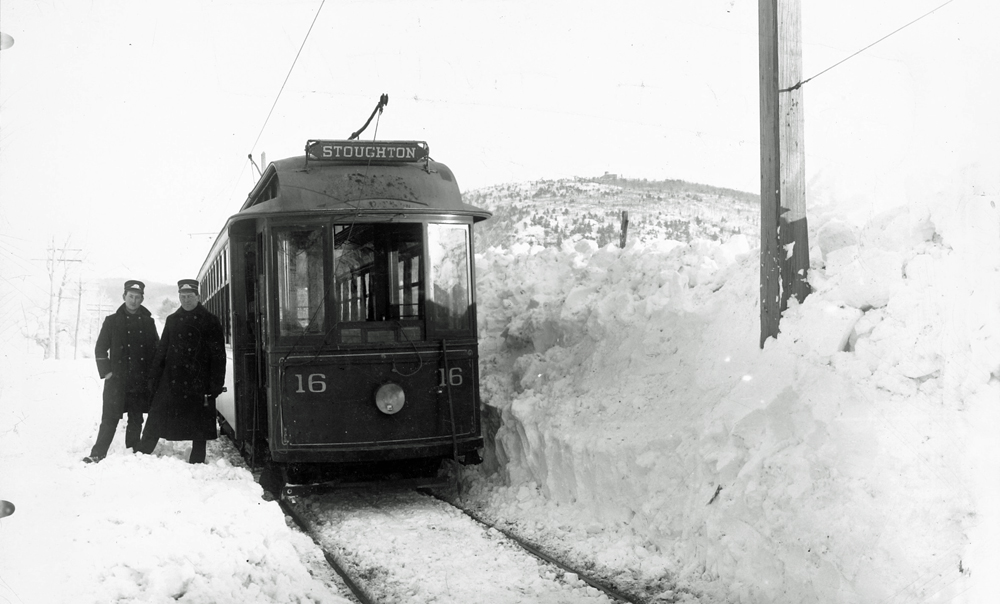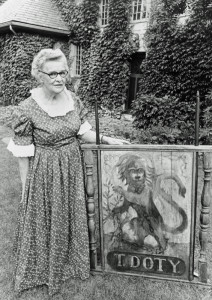True Tales: Light the Corners of My Mind
By George T. Comeau
The end of an era: the Blue Hill Street Trolley stuck in the snow (Courtesy of the Canton Historical Society)
In 1972 the town of Canton celebrated the 175th anniversary of the founding of this community. There were the usual parades, costume balls, and even a mock town meeting to carry the history forward. An old movie from 1938 was presented for young and old to reflect upon how much had changed in town. There was a full-on community push to gather everyone together to celebrate in so many ways.
It was Katherine Sullivan, a venerable and respected town historian, who conceived of an essay contest in which children and adults would share their “honest observations” and reflections of Canton. In particular the children from grades 1-8 were asked to write about what Canton would look like in 1997. Would Canton be a “large crowded town, a town free of pollution, a good place to live, site of a famous invention or home of a future president?”
That entire collection sits within a large three-ring binder. The essays are a snapshot into the memories and attitudes of our town. Most of the children knew precise information about our local history in amazing detail — likely far different that the children of today. Reading these letters today is pleasurable and bittersweet. Almost 50 years later, we get a chance to open these random jottings and look at Canton through the lens of another generation.
One of the largest themes that run throughout is the sense that in 1970 the town was filthy with trash and our rivers and streams were polluted. Billy Connolly wrote, “The water and air isn’t too clean, but Plymouth Rubber is making it worse by dumping ‘junk’ in the water.” And as an added prediction he believed that by 1997 Canton would be a “crowded, polluted, noisy and not a very nice place to live.” Many children wrote of a town-sponsored cleanup event in 1970 and the mountains of trash being removed from the local streams and woods. “Men and a few boys gathered at the Canton Airport to start the mass project, one student wrote. “They used rowboats to scour the filthy river. Such things were found as an abandoned refrigerator, an old screen door, two cars, and plenty of tires. There was so much junk…”
One DPW-minded child observed that Canton needed more sidewalks, “so little kids and maybe so older people won’t get killed.” He continued, “We need better snow removal; if you live on a side street you’ll find out why they don’t get to your street till abut two in the afternoon and after you just broke your back shoveling, then they’ll ride by and plow in your driveway or run into your car or something like that.”
Eleven-year-old Alison Curran was a smart futurist when she predicted that by 1997, “we will have electric cars, the pollution problem should be gone, all the jobs will be taken over by computers. We will have robots to run for us in all the races. The schools will be very different. You won’t even have to leave your house. You will have a TV to watch your teacher and a microphone to ask questions. You will also have a little TV camera so your teacher can see you. Pequitside Farm would have a pool and recreation center. Watchdogs would be robots programmed to bark and bite. As you can see, Canton will be quite different from the way it is now according to me.” How prescient is that?
There are letters about the Draper cows that escaped, the discovery of Native American relics and skeletons, and the wistful observations documenting the tearing down of woodlands to build new subdivisions.
One child, who shall remain nameless, wrote of a cold, snowy day in 1964 when he and his friends sought shelter in a chicken coop on the Draper estate. One of the friends “lit a match to some straw to try to warm us. Instantly, the coop was afire. One of the neighbors called the fire department.” This young man had a heavy conscience, and finished his note, “Although I am not proud of writing this letter, I thought the Historical Society should be informed, if they had not already known of this incident.”
And while the children in their youthful innocence look forward to a cleaner, less dense, and futuristic community, the adults look to the past with wistful glances that strike the reader with nostalgia and love.
J. Harriet Amrhein of Cape Code Lane wrote that “one of the nicest things to remember about Canton, and the many days we (a family of nine) enjoyed while swimming and fishing and feeding the ducks at all the ponds … In mid October I had my last swim this year in order to extend warm weather enjoyment, and exercise. It was the most delightful experience.” The words are such a simple sentiment — to enjoy the water and natural beauty of the town. (#FreeTheRez)
William Bissell’s niece typed a letter sharing his memories of “The Last Trolley.” The setting and story is delightful. Bissell’s family had moved from Iowa to Canton in 1919 and he traveled from his home in Ponkapoag to the Eliot School (now the Canton Police Station) via trolley. “My most vivid impression was the noise, the ringing and clanking of the cars as they rushed by. This was a new sound in my life, and I heard it day and night outside my window, and got to like it very much.”
Bissell’s letter continued, “Alas my trolley rides were numbered.” A huge snowstorm crippled the trolley service and buried the cars within sight of the Great Blue Hill. “The countryside became strangely quiet, what with the blanket of snow, and no trolleys passing by. We rode to school now in a hay-lined pung, drawn by two fine farm horses and driven by Jim Dalton. We sat on the floor of the pung and sang songs. One I especially remember was ‘Just a Love Nest Down on the Farm.’ Passengers in the pung were an assortment of Hansons, Kinsmans, Smiths, Hannons, Davenports and Fishers.”
There is a pattern to the letters from the adults — they all seem to yearn for the past. Take for instance the story written by Augusta “Gussie” Jones as she remembered the old gunning blind from which she hunted geese on the pond. This was Birch Point and is now Canton Pointe on Reservoir Pond, a widely acclaimed and nationally known hunting spot. Augusta was the only woman to hunt there, and her memories are precise. Live geese and ducks were bred and trained to be decoys for migrating waterfowl. “It took so many years to breed and train them that it could never happen again,” she wrote. Jones’ letter is so tender and beautiful. “I am not a writer, just a woman that loved hunting.” And her first experience was magical. “Getting up before dawn, watching daybreak as we rode along, getting there at sunrise is something I shall never forget.”
Several pages of highly descriptive prose paint a picture of lost Canton. “We had men around that fireplace from all walks of life,” she wrote. “One who had fished with President Coolidge and had pictures to prove it … we had a governor, a big silent man, that loved duck shooting and in his hunting clothes he was just one of the boys. I can remember it so much and it all seems like a dream.”
Taken as a whole, these hundreds of letters are a beautiful time capsule, best summed up by David Spector, a sixth grade student who wrote in 1972 that “Canton won’t be at all like what it is now, it probably will be highly populated. I think there will also be much building going on.” So now, 45 years later, the question is, “How are we doing?”
Short URL: https://www.thecantoncitizen.com/?p=34328











